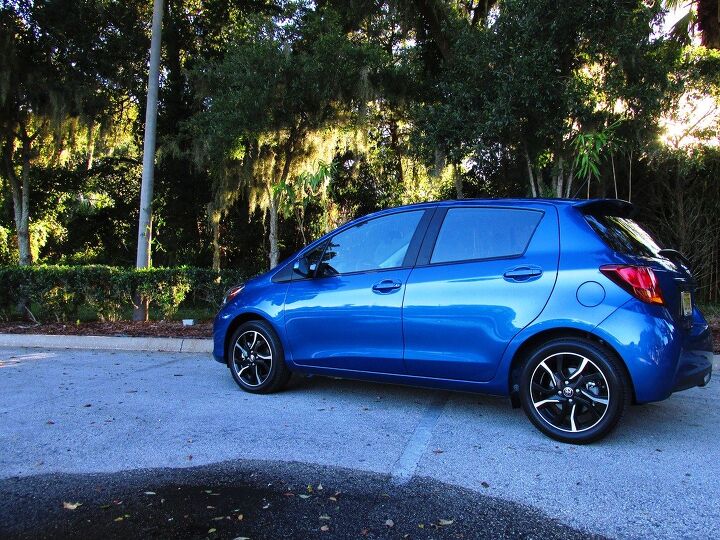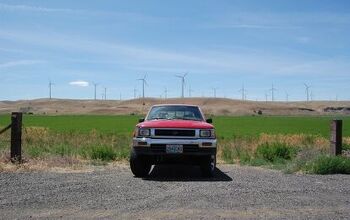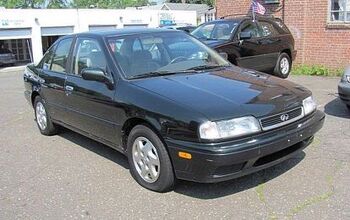Capsule Review: 2015 Toyota Yaris

2015 promises to be a big year for Toyota. The US market is increasingly important for Japan, Inc., and that market is growing. 16.4 million new light-vehicles are expected to be sold in the US in 2014, and 2015 estimates are as high as 17 million. The updated Camry will help capture a large slice of that growth, but you need competent product across the board when every basis point counts.
Yaris sales have never led the subcompact segment, but they’ve become particularly soft lately with over 50% going to fleet buyers. The new “ European flavor” of the refreshed 2015 Yaris is arriving without a moment to spare then.
Will the refresh be enough to return the Yaris to relevance, or can we still only say that “ it’s a car”?
The Yaris’ changes do not represent a full redesign, but this isn’t just an aesthetic nip and tuck at the hands of the French design team either. Interior, exterior and suspension tweaks are all welcome changes to the three- and five-door hatchback configurations. The sedan layout, dead since 2012, stays buried.
On the outside, buyers will immediately notice the new corporate fascia. A lower windshield angle, reshaped side mirrors and underbody shields aid aerodynamics. 15-in. wheels are steel on the base L trim and alloy on the LE. The SE meanwhile, receives distinctive 16-in. wheels, LED daytime running lights and piano black trim. It isn’t a dramatically more aggressive look than before, but I think the additions are cohesive in a way previous iterations of the Corolla S never managed. Amusingly, the enormous single-blade windshield wiper also returns.
The interior is both more conventional and more functional than before. Ergonomics are better, which is to say that the cupholders are no long in front of the air vents. HVAC performance is also improved, but some popular features like heated seats aren’t available. I was genuinely impressed by the steering wheel though – the stitching was good, the leather was of decent quality considering the price point and the indents in the shape fit my hands exceptionally well.
Perhaps the brightest aspect of the outgoing Yaris was its steering in SE configuration ( Car & Driver was particularly outspoken in their praise). That steering tune is now standard across all trim levels. Chassis stiffness increases thanks to 36 additional spot welds, enabling Toyota to reduce spring rates compared to 2014. Shoppers will notice the welcome increase in compliance. The short 98.8-in. wheelbase still causes some back-and-forth pitching over expansion joints though, and large bumps upset the whole car as a unit.
On the upside, stability at speed is better than expected. Wider tires are more effective in resisting tramlining than before. The front sway bar, now solid across all trims, and stiffer torsion bar in the rear both do their part to increase the sense of precision. Overall capability won’t threaten true hot hatches like the Fiesta ST, but the package is certainly well-sorted and fun.
Toyota says road and wind noise are both reduced thanks to 25% more sound deadening than before. I won’t dispute that. However, being that they planned on keeping the same 1.5 liter four cylinder, they should have added more. Allow me to offer a roundabout explanation:
The Honda Fit and Toyota Yaris both entered the US market in model year 2007. The Honda utilized a 1.5L inline four making 109 horsepower, while the Yaris’ 1.5 made 106. Fast-forward to 2015. Both models have been multiple times updated. The Honda now wrings 130 horses from 1.5 liters. The Toyota? Still 106.
Make sure to close the barn doors at night because you need every last horse on the road too. The engine note is pervasive at nearly all speeds, and it isn’t always pleasant. Keeping up with traffic isn’t Mission: Impossible on relatively flat terrain, but 2,500 RPM shifts won’t keep up pace during rush hour either. Whereas the Fit maximizes its engine output with a new CVT transmission, the Yaris soldiers on with the same 4-speed automatic or 5-speed manual. If you kvetched about this gearbox back in Jack’s 2013 review, you may as well copy-paste your comments here – they’re still fully relevant.
Fun fact: With yesteryear’s automatic, the EPA rates the Yaris just 1 mpg better on the highway than the four-cylinder Camry. Midsizers have certainly made greater efficiency gains than subcompacts over the last few years, but this is still a dubious distinction for the Yaris. The EPA calls for 30/32/36 with the autobox and 30/33/37 with the 5-speed manual.
For a few buyers though, that sort of powertrain continuity could be a selling point if construed as an indicator of reliability. In that case, you’ll likely also be pleased with the ease of servicing it. Lay a newspaper on the ground under the engine bay, open the hood and stare straight down – there’s enough space around the block to read entire stories. Compared to the plastic-shrouded aggravation DIY-types frequently have to endure these days, it’s a welcome surprise.
Every change Toyota made to the Yaris was for the better, the proven powertrain will probably start every time you twist the ignition for the next 20 years and pricing increases are modest versus 2014 models. The changes barely keep pace with the segment though. This refresh is almost certainly a stopgap measure, a placeholder for the fully redesigned version being developed with Mazda. In the meantime, the 2015 Yaris is an improved vehicle whose buyers still can’t say much beyond the fact that “It’s a car”.
Toyota provided airfare, accommodations and the tested vehicles for this review.

More by Daniel Latini
Latest Car Reviews
Read moreLatest Product Reviews
Read moreRecent Comments
- SCE to AUX All that lift makes for an easy rollover of your $70k truck.
- SCE to AUX My son cross-shopped the RAV4 and Model Y, then bought the Y. To their surprise, they hated the RAV4.
- SCE to AUX I'm already driving the cheap EV (19 Ioniq EV).$30k MSRP in late 2018, $23k after subsidy at lease (no tax hassle)$549/year insurance$40 in electricity to drive 1000 miles/month66k miles, no range lossAffordable 16" tiresVirtually no maintenance expensesHyundai (for example) has dramatically cut prices on their EVs, so you can get a 361-mile Ioniq 6 in the high 30s right now.But ask me if I'd go to the Subaru brand if one was affordable, and the answer is no.
- David Murilee Martin, These Toyota Vans were absolute garbage. As the labor even basic service cost 400% as much as servicing a VW Vanagon or American minivan. A skilled Toyota tech would take about 2.5 hours just to change the air cleaner. Also they also broke often, as they overheated and warped the engine and boiled the automatic transmission...
- Marcr My wife and I mostly work from home (or use public transit), the kid is grown, and we no longer do road trips of more than 150 miles or so. Our one car mostly gets used for local errands and the occasional airport pickup. The first non-Tesla, non-Mini, non-Fiat, non-Kia/Hyundai, non-GM (I do have my biases) small fun-to-drive hatchback EV with 200+ mile range, instrument display behind the wheel where it belongs and actual knobs for oft-used functions for under $35K will get our money. What we really want is a proper 21st century equivalent of the original Honda Civic. The Volvo EX30 is close and may end up being the compromise choice.





















































Comments
Join the conversation
Looks to be the spiritual successor to my son's 1997 Tercel. She ain't fancy, but the wee beasty is well north of 200k on the odometer, running the original engine and transmission still. 97 (or so HP), 5 speed, cloth on the doors and a soft(ish) dashboard and an A/C that would freeze large slabs of beef. We should all have a car that serves us as well as that one has. My son can easily afford something newer/sexier, but the Tercel just won't die. I could see living with a new four-door hatchback that I didn't have to worry about until near-retirement age...:)
Ahh, the magical Yaris SE with the manual transmission. It baffles me to no end that Toyota handed out the MT to all the auto journalists, yet won't actually sell it to the general public. If you go on cars.com and run a search, guess how many SE 5MTs there are within 500 miles of where I live in Washington, DC? Zero.